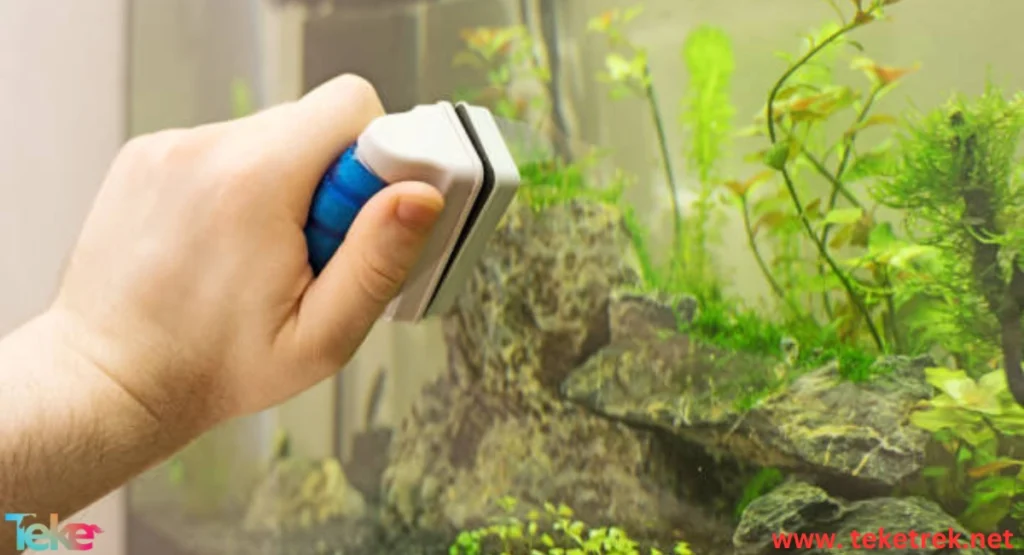Cleaning a fish tank is one of the most important tasks that must be considered. It can be done easily and simply at home without needing help or going to a fish store. Ornamental fish have specific characteristics and a particular environment in which they live. Cleaning their tank ensures the health and safety of the fish. A clean tank prevents diseases, improves water quality, and is a key factor in the overall care of ornamental fish kept in homes or shops. Cleanliness guarantees that fish grow in a healthy, disease-free environment. Here are the details in this article from teketrek.
Essential Tools Needed to Clean the Fish Tank
Before starting to clean the fish tank from sediments and debris, you must prepare all the basic tools used for cleaning. These tools include:
- Toothbrush
- A piece of sponge
- Chlorine-free water
- Small fish net
- Dechlorination device (water filter)
- Small container

Correct Steps to Clean the Tank Without Disturbing the Fish
You can clean the fish tank by following simple and quick steps to get a clean tank free of bacteria or debris that may harm or kill the fish. The process is as follows:
- Prepare all necessary tools before starting the cleaning.
- Gently remove all decorative pieces and items from the bottom of the tank.
- Fill the small container with chlorine-free water.
- Gently catch the fish with the small net and place them in the container until the tank is completely emptied of fish.
- Clean the inside of the tank using the sponge to remove any sediments.
- Clean the decorative pieces gently with a toothbrush under running water to remove stains or deposits.
- Refill the tank with chlorine-free water, then place the cleaned decorations back in.
- Finally, return the fish to the clean tank.
How to clean a fish tank with vinegar
You can use concentrated white vinegar to clean the tank from any sediments and remove stubborn or old stains. Follow these steps:
- Fill the tank with water and add one cup of white vinegar. Let it sit for one hour to allow the vinegar to react with the deposits.
- Use a sponge or cloth to scrub the stains and dirt from the tank walls.
- Clean the inside and outside of the tank gently with vinegar to avoid scratching the glass.
- Rinse the tank with lukewarm water. Clean all equipment, decorations, and algae thoroughly with a sponge, then rinse again.
- Prepare the tank to place the fish again after cleaning and disinfecting it with vinegar.
White vinegar effectively removes stains, cleans equipment, and helps remove stubborn algae.
How to Keep Your Fish Tank Clean for Longer
Here are some guidelines to keep the tank clean for a longer time without stains or debris:
- Maintain regular cleaning to ensure fish safety and preservation; cleaning twice a month is enough.
- Use hygienic cleaning tools, antifungal agents, and water purification solutions.
- Avoid removing fish every time you clean unless doing a deep cleaning. If removing fish, keep some filtered old water to minimize stress and prevent death.
The Effect of Cleanliness on Fish Health and Growth
Cleanliness greatly affects the health of fish raised in clean, stain-free tanks. This effect appears as follows:
- Clean tanks are essential to maintaining fish health.
- Cleaning removes toxic substances, bacteria, germs, and parasites that grow on tank walls.
- Accumulated bacteria and parasites can kill fish immediately.
- Dirt and sediments in the tank can cause infections and serious diseases to the fish.
Common Mistakes When Cleaning Fish Tanks and How to Avoid Them
Some common mistakes made when cleaning fish tanks include:
- Over-cleaning, which disrupts the tank’s biological balance, especially in new setups.
- Using filters that are too small for the number of fish.
- Neglecting cleaning, leading to toxic buildup.
- Adding tap water directly, which contains harmful chlorine.
- Cleaning decorations, gravel, or filters unnecessarily, which destroys beneficial bacteria and disturbs the balance.
- Overcrowding the tank with many fish in a small space.

Frequently Asked Questions
How often should I clean the fish tank?
Clean the tank once every two weeks or twice a month.
What is the best method to clean the fish tank?
Change 10-20% of the water weekly or biweekly, clean gravel with a siphon hose, wipe the glass with a special scraper, rinse the filter with old tank water to preserve beneficial bacteria, then add treated water at the correct temperature.
What should I avoid when cleaning the tank?
Do not clean the entire tank or replace all the water at once, avoid soaps or chemicals, don’t rinse the filter with tap water, and avoid cleaning gravel and decorations all at once to preserve beneficial bacteria.
Should I remove fish when cleaning the tank?
Routine cleaning does not require removing fish, but during deep cleaning or full water change, it is better to temporarily move the fish to a suitable container.
Is it safe to clean the tank with fish inside?
Partial cleaning with fish inside is safe if it does not stress them, but deep cleaning requires removing fish temporarily.
How often should I clean a tank with a filter?
Change 10-20% of the water weekly or every two weeks, clean the filter every 3-4 weeks with tank water, clean glass as needed, and avoid full cleaning unless necessary.
Conclusion
The main steps to clean a fish tank include removing debris, sediments, and waste, then changing the water and using clean, non-toxic tools to clean the glass without harming the fish. Cleaning the tank is essential and should never be neglected to prevent bacteria and parasites from multiplying and killing the fish. Also, proper feeding and monitoring the healthy growth of young fish are important parts of tank care.





